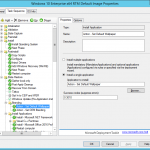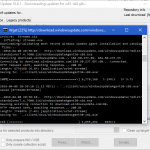Over the summer holiday period, I was assisting a school with building out an SoE for the new year. One of the things we used to do with Windows 7 was tweak the Taskbar to contain only items we were after instead of the default items of Internet Explorer, Windows Explorer and Windows Media Player. To do this we implemented a VB Script that would make the changes on the fly. And since that stopped working I’ve always wanted to sit down and try get it working again for Windows 10 and I’ll now share how I did.
You’ll want to begin by building out your Taskbar layout, add in any icons that you want and when you’re ready we can use a command to extract it. Alternatively, you can use the sample below to build your own manually, simply reference the location of the shortcuts you want to place in and the order.
<?xml version="1.0" encoding="utf-8"?>
<LayoutModificationTemplate
xmlns="http://schemas.microsoft.com/Start/2014/LayoutModification"
xmlns:defaultlayout="http://schemas.microsoft.com/Start/2014/FullDefaultLayout"
xmlns:start="http://schemas.microsoft.com/Start/2014/StartLayout"
xmlns:taskbar="http://schemas.microsoft.com/Start/2014/TaskbarLayout"
Version="1">
<CustomTaskbarLayoutCollection PinListPlacement="Replace">
<defaultlayout:TaskbarLayout>
<taskbar:TaskbarPinList>
<taskbar:DesktopApp DesktopApplicationLinkPath="%ALLUSERSPROFILE%\Microsoft\Windows\Start Menu\Programs\Firefox.lnk" />
<taskbar:DesktopApp DesktopApplicationLinkPath="%APPDATA%\Microsoft\Windows\Start Menu\Programs\System Tools\File Explorer.lnk" />
<taskbar:DesktopApp DesktopApplicationLinkPath="%ALLUSERSPROFILE%\Microsoft\Windows\Start Menu\Programs\Word.lnk" />
<taskbar:DesktopApp DesktopApplicationLinkPath="%ALLUSERSPROFILE%\Microsoft\Windows\Start Menu\Programs\Excel.lnk" />
<taskbar:DesktopApp DesktopApplicationLinkPath="%ALLUSERSPROFILE%\Microsoft\Windows\Start Menu\Programs\Outlook.lnk" />
<taskbar:DesktopApp DesktopApplicationLinkPath="%ALLUSERSPROFILE%\Microsoft\Windows\Start Menu\Programs\Microsoft SQL Server Tools 17\Microsoft SQL Server Management Studio 17.lnk" />
</taskbar:TaskbarPinList>
</defaultlayout:TaskbarLayout>
</CustomTaskbarLayoutCollection>
</LayoutModificationTemplate>
Now that we have our Layout template ready, it is simply a matter of importing it. We do so by using the Import-StartLayout command. This can also be used to import a Start Menu tile layout however in this case we are only importing the Taskbar layout. Execute the command below (replacing the path with your own).
Import-StartLayout -layoutpath \\MGS-DEPLOY-02\Scripts\TaskbarLayout.xml -Mountpath C:\
Now you can either execute this on a user login, during an MDT Task Sequence or at any other time you want.
For more info around this topic, visit the Microsoft Docs site. Hope that helps.

